Chapter 13. .Mac Troubleshooting
The tools included with your .Mac subscription are fairly straightforward and easy to use. For the most part, you shouldn’t have any trouble with them. Of course, no software is perfect. Should you run into a problem, Apple offers a wide range of support options that you should find very helpful. You can find some incredible material, for example, at www.apple.com/support/dotmac, as well as in the support section of your .Mac account.
While I can’t cover every possible problem that will have you tearing out your hair, I can offer a few solutions to the more common—and vexing—issues you may encounter. In this chapter, I’ll help you resolve a few frustrating login problems and iDisk issues, as well as offer some tips on using .Mac support.
I Can’t Log In to Some Part of .Mac
Perhaps Webmail isn’t working properly. Perhaps you’ve tried to get into your .Mac account and can’t seem to make it work. Perhaps your iDisk has become inaccessible. Occasionally, whatever the reason, something will go wrong with your .Mac login, and you won’t be able to access parts of your account. To make matters worse, you might keep getting error messages that say something like, “The service isn’t available”—not too helpful.
To resolve a login problem, there are a few things you can try.
• First, take a deep breath and walk away from your computer for a few minutes. Your .Mac password may be rejected temporarily if the mail servers are offline for maintenance. A little patience could cure this problem entirely.
• If you don’t want to wait or if waiting hasn’t helped, try resetting your .Mac password. To do this, log in to your .Mac account using a Web browser, and click the Account link in the lower left area of the homepage to open the Account Settings page. On the Account Settings page, click the Password Settings button. There, you can type a new password. You’ll have to enter the password twice: once in the Password field and once in the Password (confirm) field (Figure 13.1). When you’re done, click Submit.
Figure 13.1. By typing your password twice in this dialog, you ensure that your new password is spelled correctly. Imagine if you didn’t have to confirm the password and you misspelled it—you’d be locked out, until either you guessed your misspelling or your password was reset.
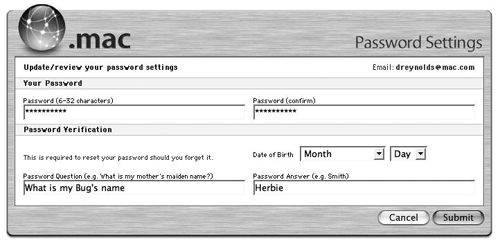
• Can’t remember your password? Go to http://iforgot.apple.com, where you can reset your AppleConnect password (Figure 13.2). Since your AppleConnect password and .Mac password are the same, do note that resetting this will reset your password for all of Apple’s services. For complete instructions on how to do this, head to Apple’s support page at http://docs.info.apple.com/article.html?artnum=86395.
Figure 13.2. Apple’s password-recovery mechanism lets you retrieve a forgotten password. This page asks for your Apple ID—that’s your .Mac e-mail address.
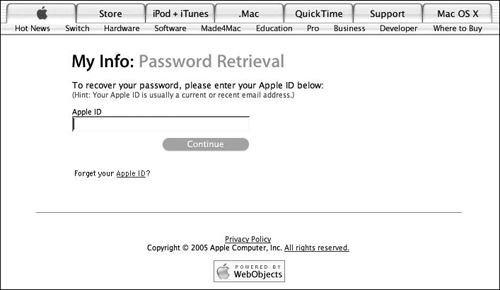
• If the problem occurs only when you use your Web browser to access .Mac services, then you may need to empty the browser’s cache. To do this with Safari, select Safari > Empty Cache (Command-Option-E) (Figure 13.3). With Microsoft Internet Explorer for the Mac, select Explorer > Preferences, and then select the Web Browser > Advanced category. In the Cache area of the window, click the Empty Now button, and then click OK (Figure 13.4).
Figure 13.3. To empty Safari’s cache, choose Empty Cache from the Safari menu. A browser cache is simply a file (or bunch of files) on your hard drive that a Web browser uses to speed up browsing.

Figure 13.4. Internet Explorer allows you to empty its meager 10 MB cache by clicking the Empty Now button in the Cache section. This may resolve some troubles with Web pages, including .Mac pages.
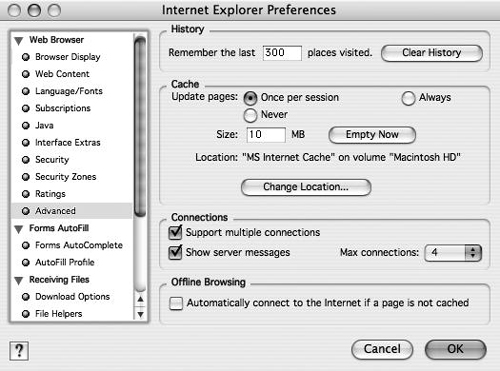
My iDisk Free Space Is Wrong
Sometimes the amount of available space on your iDisk isn’t correct—either you should have more than your iDisk says you do, or you should have less than your iDisk says you do. If you’re confronting either of these situations, you can do something about it.
To correct your reported iDisk free space, try the following:
• Wait a while. If you wait 24 hours or so—especially if you maintain a local copy of your iDisk or you’ve just upgraded your iDisk storage—the problem may correct itself. Sometimes it takes a while for these changes to take effect, or a hiccup on the server may cause the wrong disk size to be shown. If the problem hasn’t corrected itself after a day or so, it’s time to try something new.
• Try unmounting your iDisk by dragging it to the Trash and then remounting it (see Chapter 3, “Using iDisk”), which may force the disk size to be represented properly. If that doesn’t work, try unmounting your iDisk, restarting your Mac, and then remounting your iDisk.
• If you’re maintaining a local copy of your iDisk, try turning off iDisk synchronization. To do this, choose Apple menu > System Preferences and click the .Mac icon. In the .Mac pane, make sure the iDisk tab is selected. Next, click the Stop button in the iDisk Syncing On section (Figure 13.5). Wait until your iDisk shows the proper size, and then turn synchronization back on. This should also take care of cases where you receive a message that your local and remote iDisks are different sizes.
Figure 13.5. A click of the Stop button turns off iDisk synchronization. In Mac OS X 10.4, it’ll also leave you with a disk image on your Desktop that contains the contents of your iDisk, which is an easy way to create a backup of your entire iDisk.

• If you’re comfortable using Terminal, you can use it to hunt for invisible files that may be using iDisk space you don’t know about. (You can use the Get Info command when selecting folders in your iDisk to see if folders are larger than they should be.) To look for invisible files, open Terminal (in Applications > Utilities), and type the following, with each line followed by a return (and replace youriDiskname with the name of your iDisk, typically iDisk), as shown in Figure 13.6:
cd /Volumes/youriDiskname
ls -la
Figure 13.6. Although they look like near-gibberish to the uninitiated, these two Terminal commands merely move you to your iDisk and then list all of its files (visible and invisible), as shown in Figure 13.7.
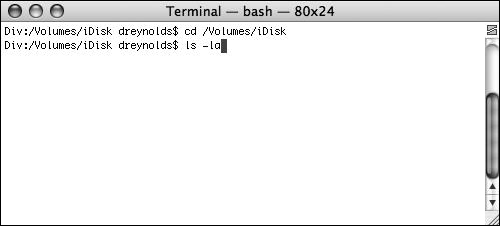
So, what’s going on here (Figure 13.7)? The cd command changes your present working directory to /Volumes/iDisk (or whatever your iDisk name is). The ls command lists the files in the iDisk’s root level. In the -la flags (which are l and a), the l flag shows the long version of the file listing (including details such as file size along with the file’s name), and the a flag shows all files—even invisible ones. Use the file listing to look for files that don’t belong, and delete them.
Figure 13.7. Well, who knew all this stuff was on an iDisk? Nothing here is amiss, though, so if we’re looking for space savings, we’ll have to look elsewhere.
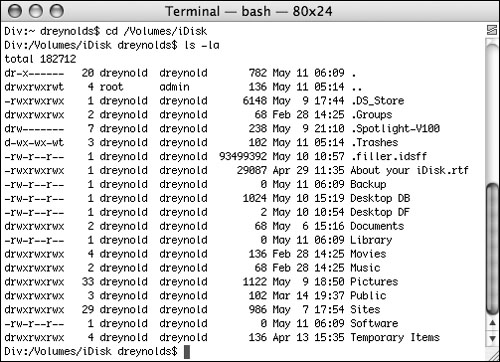
If a file name begins with a dot (or period), it’s invisible—that is, it won’t show up in the Finder or using the regular ls command. And, since you can’t see these files in the Finder, you’ll have to use a terminal command to delete them.
To delete a file with the Terminal, type rm filename, and press Return (replacing filename with the name of the file to be deleted). The file will be deleted—and you won’t be given a chance to confirm, so be sure you want to do this.
Finally, if you’re not sure what a file is, you’re best off leaving it alone.
 Tip
Tip
• Do not perform this task if you do not feel comfortable using Terminal to perform basic file manipulations.
I Can’t Connect to My iDisk
There are a few things that can cause trouble when you’re trying to access your iDisk—from failed connections to somewhat obscure errors with descriptions consisting almost entirely of negative numbers.
To troubleshoot iDisk connection problems, try the following:
• If you’re using Windows (98, 2000, or XP) to access your iDisk, try restarting your PC. If that doesn’t help, remove and then re-create the iDisk connection (see Chapter 3). You might also try using a more expanded URL with a /? (slash followed by a question mark) at the end. For example, instead of http://idisk.mac.com/membername, try http://idisk.mac.com/membername/?.
• Get a faster Internet connection. iDisk works much better with a high-speed Internet connection (as do a lot of other things). If you’re running into iDisk problems, see about a high-speed connection—especially one with a higher upload speed.
• Proxy servers can cause all kinds of connection problems. For example, iDisk Utility for Windows XP will not work with a proxy server, so you’ll have to use Network Places. If you’re still having problems, ask your ISP if it uses proxy servers, and if so, find out whether those servers support WebDAV connections. If they don’t, you’ll have trouble connecting to your .Mac account. Your ISP may be willing to find a way around the proxy server for you.
• If you’re getting a –36 error (which is a WebDAV error), make sure you’re running the latest update to Mac OS X. If that doesn’t solve the problem, then a proxy server may be the issue. Ask your ISP if it uses them and see if your ISP is willing to help you find a way around the proxy server. Also, try a faster Internet connection. This can help solve –36 errors. For more on WebDAV, see Chapter 3.
• If you’re getting a –38 error when you try to do something with your iDisk, odds are you’re trying to change a file or folder that your iDisk needs in order to work properly. If you’re trying to change iPhoto or HomePage files (in the Pictures or Sites folder) on your disk when you see this error, use iPhoto or the HomePage portion of the .Mac Web site to change them instead of doing it through the Finder. If you try to rename a file that HomePage needs to display a Web page, for example, you may see this error.
• If your iDisk password is longer than eight characters and you’re using iDisk Utility for Windows XP, use only the first eight characters of your password. iDisk Utility for Windows XP doesn’t support the longer passwords.
Using .Mac Support
Your .Mac account includes a complete support section to help you get the most out of your subscription. It’s a great place to go if you’re having a problem with your .Mac account and you don’t know where to get the answer. The .Mac support area has a number of features worth investigating (even if you’re not having troubles).
To get to your .Mac support materials, log in to your .Mac account and click the Support link on the left side of the page. This takes you to the main support page (Figure 13.8), which lists a series of help topics, as well as a sidebar full of useful links.
Figure 13.8. The .Mac support page is a gateway to scads of information that can help if you run into difficulty with any aspect of your .Mac account.

In the main help area, you can find assistance with the following:
• .Mac account setup and billing
• .Mac Mail
• iDisk
• .Mac Sync
• Creating Web sites (and blogs, and podcasts, and Photocasts...) using iWeb, HomePage, and Apple’s iLife applications.
• .Mac Groups
• Sharing Address Book contacts and iCal calendars
• Using Backup
To access any of these help topics, click the headline above the description. This loads a page of frequently asked questions on the selected topic. At the bottom of the page you’ll find an e-mail form that you can use to ask questions of .Mac staffers, who will try to get you an answer within 24 hours.
The sidebar along the left side of the page has a series of links to other useful resources, including the following:
• A search engine that looks through Apple’s support Knowledge Base—a trove of articles about known work-arounds for a vast number of Mac-related troubleshooting issues. Check the Restrict to .Mac Articles box to limit results to .Mac-related topics (Figure 13.9).
Figure 13.9. Checking the Restrict to .Mac Articles box when you search the huge Apple Knowledge Base will limit your results to relevant topics.

• At-a-glance indicators that show the current status of the .Mac network, iDisk, .Mac e-mail, and HomePage (a green circle is good) (Figure 13.10).
Figure 13.10. Colored indicators display the status of various .Mac services: Green means all is well; red means there’s a temporary outage.
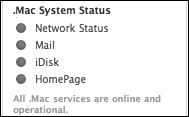
• A link to the .Mac Learning Center, a great set of tutorials on a variety of .Mac-related projects and tasks—many of them including QuickTime movies that illustrate tricks and techniques.
• A link to the .Mac discussion boards, part of the larger Apple support discussion boards, where you can ask questions and swap advice with fellow .Mac users and members of the Apple support staff.
• A link to the “Getting Started with .Mac” PDF, which is worth downloading.
• A link to the .Mac feedback form, with which you can sound off about .Mac.
